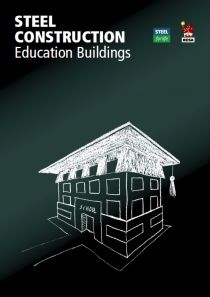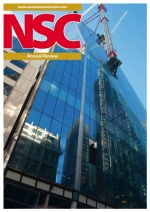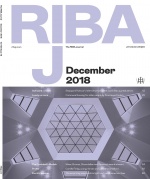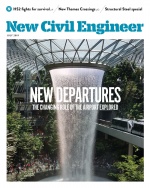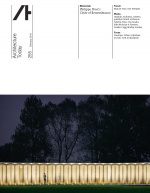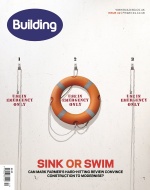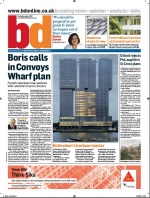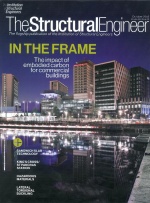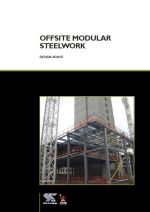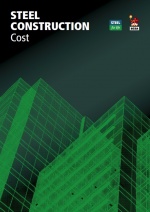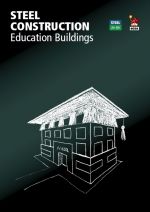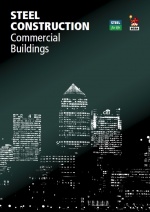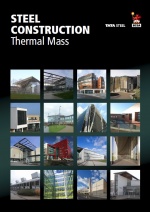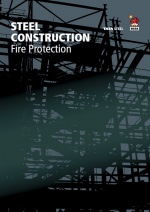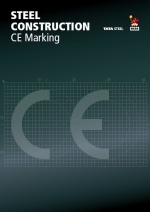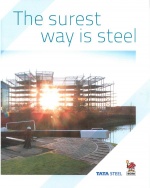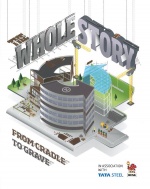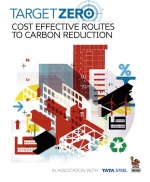Steel construction news
- CM SSDA 2019.jpg
- Building January 2020.jpg
[top]New Steel Construction magazine
Image does not exist
New Steel Construction (NSC) magazine is provided free of charge ten times a year by the BCSA and Steel for Life, designed to keep you up to date on key developments in steel construction with a blend of industry news, current project reports, interviews with key industry figures and technical features from the SCI.
The magazine is available free of charge in a paper format for the UK and Ireland as well as in a digital format for use on tablets, smartphones and desktop computers. A regularly updated website also carries news of steel construction issues and projects, as well as the NSC digital library containing the current issue and archives.
The Advisory Desk or AD Notes published in every issue have been brought together and are available here.
To sign up for and manage your FREE subscription
If you already have an account on SteelConstruction.info:
- Click the ‘Log in / Create Account’ button in the top left corner
- Enter your username and password, and click ‘Log in’
(If you cannot remember your password, use the ‘Forgot your password?’ facility)
- Click the ‘Preferences’ link in the top left corner
- Tick the box to receive either digital or printed NSC magazine, or both, and enter / edit the required contact information
- Click ‘Save’
If you don’t have an account on SteelConstruction.info:
- Click the ‘Log in / Create Account’ button in the top left corner
- Click the ‘Join SteelConstruction.info’ button
- Enter the required details to create an account, including your email address
- Tick the box to receive either digital or printed NSC magazine, or both
- Click ‘Create your account’
- You will receive an email asking you to confirm your email address (i.e. a validity check)
Alternatively, simply email your details to info@steelconstruction.org
[top]NSC Annual Review
The NSC Annual Review ran from January 2015 to January 2018 and brought together a number of projects featured in NSC magazine throughout each year that highlighted the benefits of using structural steelwork for construction projects. These case studies were real proof of the cost, programme, safety and performance benefits of using steel framing.
Each article told a different story and while they may have been very different projects, in all cases the use of steel framing had delivered a suite of benefits to the design team, the construction programme, the building owners and its users.
These publications also showcased the wider benefits of steel under a number of headings – such as safety, speed of construction, cost, quality, sustainability, innovation, offsite manufacture, and key performance attributes such as vibration and acoustics.
NSC Annual Reviews:
NSC Annual Review Jan15
NSC Annual Review Jan16
NSC Annual Review Jan17
NSC Annual Review Jan18
[top]NSC Technical Digest
Image does not exist This NSC Technical Digest brings together all of the Advisory Desk Notes and Technical Articles from the steel construction sector published in NSC magazine throughout 2019. All of these articles can also be found on www.newsteelconstruction.com but we have responded to requests to bring them together in a separate format with this publication, the fourth in what is an annual series of Technical Digests.
AD Notes reflect recent developments in technical standards or new knowledge that designers need to be made aware of. Some of them arise because a question is being frequently asked of the steel sector’s technical advisers. They have always been recognised as essential reading for all involved in the design of constructional steelwork.
The longer Technical Articles offer more detailed insights into what designers need to know, often sparked by legislative changes or changes to codes and standards. Sometimes it is simply felt that it would be helpful if a lot of relatively minor changes, perhaps made over a period of time, were brought together in one place, so a technical update is needed. We hope you find this new publication of value.
NSC Technical Digest 2016
NSC Technical Digest 2017
NSC Technical Digest 2018
NSC Technical Digest 2019
[top]Construction Manager – SSDA Special
Image does not exist
Published ten times per year, Construction Manager is the widest read construction title in the UK providing construction professionals with informed news, views, analysis, detailed technical articles and interviews. In the November 2019 issue it included a special feature showcasing the Structural Steel Design Awards 2019.
[top]RIBA Journal – Steel Intelligence
The official publication of the Royal Institute of British Architects, RIBA Journal includes a series of supplements, Steel Intelligence, covering steel construction project case studies and current topics of interest to Architects and others involved in design and construction with steel.
Steel Intelligence 1 - Derby Arena, Monument Place, Thermal mass and Stansted Airport, June 2014
Steel Intelligence 2 - 6 Bevis Marks, Merchant Square footbridge, Embodied carbon and Hunstanton School, October 2014
Steel Intelligence 3 – Reading Station, Costing steel, Stonehenge Visitor Centre and Gateshead Millennium Bridge, January 2015
Steel Intelligence 4 – St John Bosco Arts College, BIM, 199 Westminster Bridge Road and Leadenhall Building, June 2015
Steel Intelligence 5 – Leeds Station Southern Entrance, Long spans, 5 Broadgate, and the Royal Albert Bridge, May 2016
Steel Intelligence 6 – Ashton Old Baths, circular economy, University of Cambridge Primary School, and Exchange House, January 2017
Steel Intelligence 7 – The Ordsall Chord, fire Q&As, Greenwich Peninsular Energy Centre, and Brexit/supply chain comment, December 2018
[top]Building magazine – Costing Steelwork
‘Costing Steelwork’ is a series in which Cost consultants AECOM provides guidance on the key elements of costing structural steelwork. These articles, which are published in Building magazine every quarter, examine the key cost drivers for different sectors, provide a building type specific cost comparison and include a cost table with indicative cost ranges for various frame types. These cost ranges can be used to act as a comparative cost benchmark. Subsequent articles will include cost comparison updates for each sector to ensure the cost data remains current.
The series comprises studies into commercial, education, mixed-use, retail and industrial buildings. Each article also examines the process of cost planning throughout the design stages, and provides a market update on tender price trends.
Image does not exist
Costing Steelwork 1 – Commercial Buildings, April 2017
Costing Steelwork 2 – Education Buildings, July 2017
Costing Steelwork 3 – Industrial Buildings, October 2017
Costing Steelwork 4 – Retail Buildings, January 2018
Costing Steelwork 5 – Residential / Mixed-use Buildings, April 2018
Costing Steelwork 6 – Cost update and long-span, column-free design, July 2018
Costing Steelwork 7 – Cost update and cost drivers for framing materials, October 2018
Costing Steelwork 8 – Cost update, February 2019
Costing Steelwork 9 – Cost update, April 2019
Costing Steelwork 10 – Cost update, July 2019
Costing Steelwork 11 – Cost update, October 2019
Costing Steelwork 12 – Cost update, January 2020
[top]New Civil Engineer – Structural Steelwork in Action
New Civil Engineer is the magazine of the Institution of Civil Engineers. It publishes a regular special report, Structural Steelwork in Action, which covers the crucial role played by structural steelwork in the UK construction supply chain.
Structural Steelwork in Action 1 – October 2011
Structural Steelwork in Action 2 – November 2012
Structural Steelwork in Action 3 – November 2013
Structural Steelwork in Action 4 – November 2014
Structural Steelwork in Action 5 – April 2015
Structural Steelwork in Action 6 – November 2015
Structural Steelwork in Action 7 – April 2016
Structural Steelwork in Action 8 – November 2016
Structural Steelwork in Action 9 – June 2017
Structural Steelwork in Action 10 – December 2017
Structural Steelwork in Action 11 – June 2018
Structural Steelwork in Action 12 – June 2019
[top]Structural Steel Design Awards
The Structural Steel Design Awards 2019 brochure was produced by the BCSA and Trimble Solutions (UK) Ltd in association with Kovic Design Limited.
Five projects were Award winners at this year’s Structural Steel Design Awards (SSDA), which were announced at a special presentation held at LSO St Luke’s, London on 1st October 2019. The winning projects were Coal Drops Yard, London., Taplow Riverside Footbridge, Tombola HQ, Sunderland, Tottenham Hotspur Football Club, New Stadium and Wimbledon No.1 Court. Six projects also received Commendations, namely Battersea Arts Centre, Chiswick Park Footbridge, Fen Court, London, Ingenuity House, Birmingham, Neuron Pod, London and Royal Academy of Music, London. Four projects received Merits, namely G W Annenberg Performing Arts Centre, Greatham Creek Seal Hide, Middlesbrough, Telford Central Footbridges and The Macallan Distillery.
Tottenham Hotspur Football Club, New Stadium also won the ‘Project of the Year’ award.
Television news presenter Emma Crosby presented the awards, now in their 51st year. The judges selected the Award-winning projects from a short list of 20, with all entries scoring highly in efficiency, cost effectiveness, aesthetics, sustainability and innovation.
Previous commemorative brochures:
SSDA 2018, SSDA 2017, SSDA 2016, SSDA 2015
SSDA 2014, SSDA 2013, SSDA 2012
[top]Steel for Life - Steel Stories
‘Steel Stories’ was a series of e-newsletters highlighting steel-related news and resources available from Steel for Life. Each issue focussed on a key topic and also acted as a signpost to some interesting case studies and useful steel-related resources. There were three versions of the newsletter available for design and construction professionals depending on their information needs;
Commercial
Tailored for construction professionals, cost consultants and quantity surveyors interested in current cost related information, and case studies of steel-framed buildings.
Steel Stories 1 - Commercial, September 2017
Steel Stories 2 - Commercial, May 2018
Design
Tailored for architecture and design professionals interested in case studies of steel-framed buildings and topic related information.
Steel Stories 1 - Design, September 2017
Steel Stories 2 - Design, May 2018
Detail
Tailored for engineering professionals providing case studies of steel-framed buildings, updates on resources and tools for those involved in designing steel frames.
Steel Stories 1 - Detail, September 2017
Steel Stories 2 - Detail, May 2018
[top]Construction News – Steel Spotlight
Construction News is a leading weekly source of news for the UK construction sector. From 2011 to 2018, it included a regular supplement, Steel Spotlight, covering steel construction project case studies and current topics of interest to everyone in the construction supply chain with an interest in steel construction.
Steel Spotlight 1 – SSDA 2011: The Amex Community Stadium, and St Botolph Building, July 2011
Steel Spotlight 2 – Co-operative HQ, Big Yellow and the Mary Rose Museum, November 2011
Steel Spotlight 3 – St George’s Park, and Cheltenham East Fire Station, February 2012
Steel Spotlight 4 – The Shard, Thermal Mass, and the North East Quadrant Regents Park, May 2012
Steel Spotlight 5 – SSDA 2012: Walbrook Building, and the Royal Shakespeare Theatre, July 2012
Steel Spotlight 6 – Brent Civic Centre, Trinity Square, and Fire Engineering, November 2012
Steel Spotlight 7 – 20 Fenchurch Street, BREEAM, Royal Greenwich UTC, March 2013
Steel Spotlight 8 – Nottingham Express Transit, 6 Bevis Marks, Mansfield Bus Station, June 2013
Steel Spotlight 9 – Aberdeen health village, Derby sports arena, Sainsbury’s Longbridge, Ardley EfW plant, September 2013
Steel Spotlight 10 – Manchester Victoria Station, Manchester Cancer Research Centre, Hallsville Quarter, December 2013
Steel Spotlight 11 – Aldgate Tower, Swansea University Bay Campus, Redcar Leisure and Community Heart, April 2014
Steel Spotlight 12 – Leadenhall Building, Silverburn Shopping Centre, St. Thomas' Hospital, Embodied Carbon, October 2014
Steel Spotlight 13 – SSDA 2015: Moorgate Exchange, Imperial War Museum and Derby Arena, July 2015
Steel Spotlight 14 – SSDA 2016: Harlech Castle Footbridge, The Memorial Spire, London Olympic Roof Conversion, Etihad Stadium South Stand, and Thames Tower Reading, October 2016
Steel Spotlight 15 – SSDA 2017: The Leadenhall Building, T-Pylon, LSQ London, HGV Egress Ramp, Selfridges and Oriam, October 2017
Steel Spotlight 16 – SSDA 2018: London Bridge Station, Knostrop Weir Foot and Cycle Bridge, Jaguar Land Rover Engine Manufacturing Centre, V&A's Exhibition Road Quarter, Bloomberg London and The Ordsall Chord Viaduct, November 2018
[top]Architecture Today – Steel Solutions
The monthly magazine produced for the architectural community included a bi-annual supplement in 2014-15, Steel Solutions, covering steel construction project case studies and current topics of interest to Architects and others involved in design and construction with steel.
Steel Solutions 1 – Splashpoint Leisure Centre, Engineering & Computing Building (ECB) at Coventry University, Thermal Mass, July 2014
Steel Solutions 2 – The Francis Crick Institute, Slough Cultural Centre, Calculating Embodied Carbon, February 2015
[top]Building magazine – Steel Insight
Cost consultants Gardiner & Theobald produced a quarterly article from 2011 to 2016, Steel Insight, published in Building magazine, covering the cost of structural steelwork. The series provided guidance across a range of cost-related topics and market sectors for anyone in the supply chain with an interest in the cost of steelwork. Each issue of Steel Insight included a table of indicative costs for structural steelwork and associated products that were current at the time.
Steel Insight 1 – Structural steelwork, October 2011
Steel Insight 2 – Cost planning through design stages, January 2012
Steel Insight 3 – Comparative cost study - Multi-storey offices, April 2012
Steel Insight 4 – Cost planning of steel-framed multi-storey buildings, July 2012
Steel Insight 5 – Education buildings, October 2012
Steel Insight 6 – Industrial buildings, February 2013
Steel Insight 7 – Healthcare, April 2013
Steel Insight 8 – Multi-storey commercial buildings, July 2013
Steel Insight 9 – Cost planning structural steelwork, November 2013
Steel Insight 10 – Key frame cost drivers, May 2014
Steel Insight 11 – Cost update and case studies: Commercial buildings, November 2014
Steel Insight 12 – Cost update and case studies: Industrial buildings, March 2015
Steel Insight 13 – Cost update and case studies: Retail buildings, July 2015
Steel Insight 14 – Cost update and case studies: Leisure buildings, October 2015
Steel Insight 15 – Cost update and case studies: Education buildings, February 2016
Steel Insight 16 – Cost update and case studies: Commercial buildings, May 2016
Steel Insight 17 – Cost update and case studies: Retail buildings, July 2016
Steel Insight 18 – Cost update and case studies: Industrial buildings, October 2016
[top]Building Design magazine – Steel Focus
The weekly newspaper for Architects, Building Design magazine, included a quarterly supplement from 2011 to 2013, Steel Focus, covering steel construction project case studies and current topics of interest to Architects and others involved in design and construction with steel.
Steel Focus 1 - Media City Footbridge, Royal Shakespeare Theatre and Target Zero, April 2011
Steel Focus 2 - SSDA 2011 - Cannon Place, The Rose Bowl, and The River Suir Bridge, July 2011
Steel Focus 3 - Neo Bankside, Bramall Music Building and Fire Protection, October 2011
Steel Focus 4 - The Shard, and Maggie’s Care Centre, February 2012
Steel Focus 5 - The Crystal urban sustainability centre, Leeds Arena and Thermal Mass, May 2012
Steel Focus 6 - SSDA 2012 - The Velodrome, Peace Bridge, and Olympic Stadium, July 2012
Steel Focus 7 - Ducie Court student accommodation, and Leadenhall, London, November 2012
Steel Focus 8 - Isaac Newton Academy, London, and Co-operative Group HQ, Manchester, February 2013
Steel Focus 9 – Brent Civic Centre, Twin Sails Bridge, Poole Harbour, and Embodied Carbon, May 2013
Steel Focus 10 – 20 Fenchurch Street, University of Winchester, and Cost Analysis, July 2013
Steel Focus 11 – Heathrow Terminal 2, Stoke-on-Trent Bus Station, Fire protection, November 2013
[top]The Structural Engineer
The Structural Engineer is the magazine of the Institution of Structural Engineers. It covers news as well as techncial articles and features of relevance to structural engineers involved in steel design and construction.
A comparative embodied carbon assessment of commercial buildings - October 2012
[top]Offsite modular steelwork
With support from Innovate UK, a collaborative project was established in 2019 to investigate the opportunities to increase construction sector productivity by the use of offsite steel modules. The output published here takes the form of two guides:
SCI P431 Offsite modular steelwork - Advice to clients, 2020
SCI P430 Offsite modular steelwork - Design advice, 2020
The client guide highlights the benefits of increased offsite construction, which include higher quality, faster construction and reduced safety risks, and presents steel solutions at a conceptual level. The companion design guide presents more detailed design information for the technical solutions identified during the project for engineers and architects encompassing:
Section 1 - The advantages of an integrated, offsite solution.
Section 2 - The design of steel concrete composite cores, which in some circumstances offer benefits of speed, accuracy, strength and stiffness, compared to a concrete core.
Section 3 - The design of single storey columns, with concrete encasement if desired, which are highly suited for offsite manufacturing using robotic fabrication techniques.
Section 4 - “Dry” floor plates, erected as individual panels, which have the significant advantage of removing a number of processes from site, including the casting of concrete.
Some proposed solutions may have higher initial costs than the orthodox alternative, or may have other disadvantages such as increased floor depth. In all cases, a holistic view of the proposed solution must be taken, valuing the benefits whist recognising any disadvantages of a proposed solution. The project team also recognised that further advantages are possible by integrating services into the structural solution, but that for various reasons, those advantages are not always realised. Section 5 describes the main reasons which militate against the regular integration of services and simply points out the necessary project characteristics if benefits from service integration are to be gained.
The project partners were:
The British Constructional Steelwork Association Ltd (BCSA)
The Steel Construction Institute (SCI)
Severfield
WSP
Trimble
Valuable guidance was also provided by:
William Hare Group Ltd
Caunton Engineering Ltd
Billington Structures Ltd
BSRIA
British Steel
SPIE
[top]Steel construction – Cost
The Steel construction - Cost supplement was produced by the BCSA and Steel for Life and was distributed in hard copy with the main UK construction press in May 2018. The digital version available here has been updated with costs current as of Q4 2019.
Attitude surveys have confirmed that cost is often the key driver in selecting the framing material for a building, so it has been a major element in the decision-making process that has given steel construction market shares of over 90% in single storey industrial buildings and around 70% in multi-storey buildings.
Just as the design and construction process has to be just right, it is also important that the costing process is undertaken properly if correct decisions are to be reached. The steel sector recognises the importance of achieving accurate cost estimates and has invested in providing guidance and assistance to the construction professionals involved for some years. One result is Costing Steelwork, a regular series from AECOM, BCSA and Steel for Life published quarterly in Building magazine that provides guidance on costing structural steelwork. Costing Steelwork examines the process of cost planning through the design stages, highlights the key cost drivers for different sectors and provides building type-specific cost comparisons. It also includes a cost table, which indicates cost ranges for various frame types that can be used at all design stages to act as a comparative cost benchmark.
This Steel construction – Cost publication gathers together the first five issues in the series to provide comprehensive guidance across the five sectors covered by the study, namely office, education, industrial, retail and mixed-use buildings with costs current as of Q4 2019.
[top]Steel construction – Education Buildings
The Steel construction – Education Buildings supplement was produced by Steel for Life and the BCSA and distributed with the main UK construction press in January/February 2020. The publication gives an overview of the education buildings sector and is the latest in a series of publications from the steel sector that aims to keep construction professionals abreast of developments that will help them in design and construction of steel-framed buildings.
Using case studies of real projects that are either under construction or recently completed, the reasons why steel frames are consistently the preferred market choice for education buildings are explained. Speed of construction, cost-effectiveness, sustainability and future flexibility are just some of the reasons why steel frames are selected for around 60% of education buildings.
The steel construction sector has provided many of the finest buildings in use by educational establishments of all types, from primary and secondary schools and schools for children with special needs, to leading research establishments for universities, involving large student accommodation blocks, sports halls and other leisure facilities like swimming pools. This publication showcases how the use of steel, the most modern method of construction, can help to provide the education buildings the UK’s future depends on.
[top]Steel construction – Commercial Buildings
The Steel construction – Commercial Buildings supplement was produced by Steel for Life and the BCSA and distributed with the main UK construction press in November 2016. The publication gives an overview of the multi-storey office buildings sector and is the latest in a series of publications from the steel sector that aims to keep construction professionals abreast of developments that will help them in design and construction of steel-framed buildings.
Using case studies of real projects that are under construction, the reasons why steel frames are consistently the preferred market choice for multi-storey buildings are explained. Cost data from model studies of the sort of buildings that are actually being constructed in the UK explain why on cost grounds alone steel frames are selected for around 70% of multi-storey commercial buildings.
Case studies also show steel’s inherent on-site advantages, regularly delivering the savings on construction programmes that make life so much easier for hard-pressed construction teams. Just in time delivery of offsite fabricated steel chimes perfectly with the drive towards modern methods of construction, and the recent Farmer Review finding that construction’s survival as an industry may depend on more widespread adoption of such techniques.
[top]Steel construction – Floor vibration
The Steel construction – Floor vibration supplement was produced by Steel for Life and the BCSA and was be distributed with NSC magazine in May 2016.
For most multi-storey commercial buildings, straightforward steel construction will meet the required vibration performance criteria without modification. For more vibration-sensitive applications, such as hospital operating theatre floors or research laboratories, steel’s advantages can be utilised, although stiffer solutions may be necessary. Even if a stiffer floor is required, steel remains the most cost-effective and lightweight solution.
Long-span applications, for which steel is the only option, have been found to offer good dynamic performance, despite common preconceptions that steel composite floors are thought to be livelier than concrete ones. This is because the stiffer beams and large mass of the long-span floor plates, which participates in any motion, reduce the magnitude of the vibration response. The steel sector has extensive experience in designing steel structures to ensure compliance with even the strictest vibration performance criteria.
This guide is an introduction to the subject of floor vibrations. It describes what they are, what levels are acceptable and how they are assessed, and introduces a new web-based simple design tool.
[top]Steel construction – Embodied Carbon
Image does not exist The Steel Construction – Embodied Carbon supplement was produced by Tata Steel and the BCSA in September 2014.
The term ‘embodied carbon’ refers to the lifecycle greenhouse gas emissions that occur during the manufacture and transport of construction materials and components, as well as the construction process itself and end of life aspects of the building. In recent years, the embodied carbon of construction materials has become synonymous with the term ‘carbon footprint’.
As the operational energy efficiency of buildings is improved, the relative importance of the embodied carbon impact is increasing. As a consequence, it is receiving more attention by designers.
The purpose of this guide is to give designers an overview of how embodied carbon should be considered, some practical guidance on how to assess embodied carbon on individual projects and some case studies on how structural steelwork compares with other framing materials.
[top]Steel construction – Thermal mass
The Steel construction - Thermal mass supplement was produced by Tata Steel and the BCSA and distributed with the main UK construction press between January and early March 2014.
Thermal mass describes the ability of the fabric of a building to absorb and store heat. Used effectively, it can reduce cooling loads and, in some cases, remove the requirement to provide air conditioning. In most multi-storey buildings, the thermal mass is provided by the concrete in the upper floor slabs.
This guide is an introduction to the use of thermal mass to reduce operational energy use in non-domestic buildings in the UK. It describes thermal mass and explains how it can be used as part of a fabric energy storage (FES) strategy to achieve sustainable, energy efficient buildings.
It dispels the myth that thermal mass is only effective in heavyweight buildings with thick concrete floors and demonstrates that fabric energy storage strategies are equally effective in structurally efficient, steel-framed buildings.
[top]Steel construction – Fire Protection
The Steel construction - Fire Protection supplement was produced by Tata Steel and the BCSA and distributed with the main UK construction press in September/October 2013.
More is known about structural steelwork in fire than any other construction material. Its performance has been determined through a series of full-scale fire tests, which are unparalleled for other materials.
Determining the fire protection requirements for the structural steelwork of a building is a simple and straightforward process, consistent across all types of common buildings. The procedure is clearly set out in this document, which is intended to be a reference aid for designers at all levels. Whilst it is a standalone guide, it also points the designer to the wealth of online articles available on this topic.
[top]Steel construction – CE Marking
The Steel construction – CE Marking supplement was originally produced by the BCSA and Tata Steel in association with Barrett Byrd Associates, and distributed with key construction titles during March/April 2013. Since then it has been updated to reflect the passing of time, and most recently a change in the procedure for selecting the Execution Class for a structure. This is version 4.
CE Marking for all construction products, covered by a harmonised European standard or conforming to a European Technical Assessment became mandatory on 1 July 2013. For fabricated structural steelwork, CE Marking became mandatory on 1 July 2014. This represents a major development for engineers, contractors and steelwork specialists and it demands careful attention to the new obligations imposed.
This 20-page publication highlights how the steel construction sector has been working behind the scenes towards achieving CE Marking. Perhaps more importantly, it spells out in detail what it will mean for the rest of the construction sector and what you need to do to comply with the Construction Products Regulation that is the legal basis for the new regime.
[top]The surest way is steel
The Surest Way is Steel was produced by the BCSA and Tata Steel and distributed with the main UK construction press in summer 2012. It contains a summary of the benefits of steel construction, including articles on health and safety, sustainability and the cost of structural steelwork, as well as project case studies from the residential and multi-story office sectors.
[top]The whole story – from cradle to grave
The whole story – from cradle to grave, was produced by the publishers of Building magazine and Building Design magazine in association with Tata Steel and the BCSA. It investigates the whole lifecycle assessment of construction materials from sourcing to end of life. It includes a foreword by Paul King, Chief Executive of the UK Green Building Council.
[top]Target Zero – Cost effective routes to carbon reduction
The Target Zero ‘Cost Effective Routes to Carbon Reduction’ supplement was produced by the publishers of Building magazine and Building Design magazine in association with Tata Steel and the BCSA in February 2011. The supplement gives readers an introduction into the Target Zero study, a research project to determine the most cost-effective combinations of materials and technologies needed to make low and zero carbon buildings a reality. It also presents the results and key findings to give clients and designers a clear steer on early decisions for the five different building types studied: schools, warehouses, supermarkets, offices and mixed-use.
Target Zero is the largest and most comprehensive study undertaken to date to assess and compare the sustainability performance of new non-domestic buildings in the UK. All building and alternative structural options, energy efficiency measures and renewable energy technologies analysed were independently costed.
Target Zero was undertaken by a consortium of leading organisations in the field of sustainable construction: AECOM and The Sweett Group (now part of Currie & Brown) with steel construction expertise provided by Tata Steel Europe RD&T and the Steel Construction Institute (SCI). Full results and guidance from the programme are freely available.




